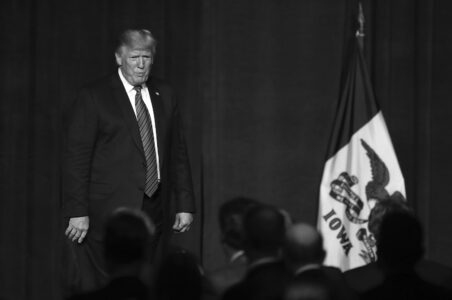C-SPAN gives you a front row seat to your government
Since first being sworn into the U.S. Senate during the 97th Congress on Jan. 3, 1981, I’ve entered the rectangular, two-story chamber located on the north wing of the U.S. Capitol countless times to introduce legislation, deliver a speech or cast my vote on behalf of Iowans. It’s a privilege to represent my home state in the greatest deliberative body in the world. Even after all these years, I’m humbled every time I step foot into the historic chamber, furnished with 100 iconic desks and encircled by the Visitor’s and Press Gallery.
For more than four decades, and counting, I’ve joined my colleagues to debate public policy, shed light on wrongdoing and celebrate historic milestones. I’ve cast votes giving my assent or dissent to nominations and legislation on matters both foreign and domestic, on issues from A to Z.
For a period of time – spanning more than 27 years – I held the longest voting streak in Senate history. My 8,927 consecutive roll call votes ended in November of 2020, when I had to quarantine for exposure to COVID-19. My good friend from Maine, Senator Susan Collins now holds that baton, as she continues her unbroken voting streak since she was sworn into office in 1997.
During the 116th Congress and now in the 119th Congress, I’m honored to serve as Senate President pro tempore. From this leadership position, I open the Senate’s daily session, lead the Pledge of Allegiance and often take the opportunity to deliver brief remarks during Morning Business.
When the Senate convened for the first time in 1789, it did so behind closed doors. Six years later, senators voted to open legislative sessions to the public. Since 1890, visitor passes have allowed people to watch Senate proceedings in person.
The window into the Senate changed dramatically 39 years ago. On June 2, 1986, every minute of the people’s business has been made available live to the public, from memorable moments – including televising 16 Supreme Court nomination debates and three presidential impeachment trials – to the mundane.
Thanks to C-SPAN 2, viewers can see the swearing-in of newly elected members, watch all-night sessions during vote-a-ramas and watch history underway from their living rooms or laptops.
I was a member of the House of Representatives in 1979 when C-SPAN began its gavel-to-gavel coverage and appreciated its mission to foster civic engagement and let the sunshine in on the people’s business.
Senator Amy Klobuchar and I introduced a bipartisan resolution to recognize C-SPAN 2 and support its stewardship of transparency. This public service provides live, nonpartisan coverage, allowing Americans to see and hear their elected representatives in real time. Our resolution calls on television providers, including streaming services, to make C-SPAN public affairs programming available to all Americans on all platforms. C-SPAN does not receive any taxpayer dollars. It is funded primarily from satellite and cable providers.
For the tens of millions of Americans who have cut the cord and get their content on streaming services, they should not be cut off from the civic content made available by C-SPAN.
This nonprofit network gives Americans a front row seat to the legislative branch, providing direct access to debates and deliberations that impact their lives and livelihoods.
Just consider its archive of history spanning nearly four decades:
Recorded more than 43,830 hours of Senate sessions that span the spectrum of political views, policy debates and personal testimony, including more than 169,000 speeches;
Documented more than 23,439 roll call votes, providing a live testimonial of Senate decision-making;
Preserved the voices of 359 U.S. Senators, including 185 Republicans, 167 Democrats and 7 Independents;
Followed the leadership eras of 5 Republican and 5 Democrat Senate leaders, respectively.
It just so happens, on C-SPAN 2’s inaugural day on June 2, 1986, I took a turn as presiding officer during that first televised session and also delivered floor remarks to introduce a bill on human rights and free speech issues that involved protestors outside the then-Soviet embassy here in Washington, D.C.
As an advocate for civic engagement and transparency, I applaud C-SPAN’s commitment to chronicling democracy in action in Congress, as well as its public affairs programming that delivers unbiased coverage of America’s political landscape.
What’s good for the goose, is good for the gander. For more than 20 years, I’ve pushed to allow cameras into the federal courtroom, including the Supreme Court, to foster a better understanding of the federal judiciary and its role in our system of checks and balances and in resolving legal disputes.
Keeping C-SPAN’s cameras rolling here in Congress keeps lawmakers accountable by providing a valuable conduit for civic engagement and civic education. As James Madison wrote in 1822, some 35 years after he helped write the Constitution:
“A popular Government, without popular information, or the means of acquiring it, is but a prologue to a Farce or Tragedy; or perhaps both. Knowle[d]ge will for ever govern ignorance: and a people who mean to be their own Governours, must arm themselves with the power which knowledge gives.”
C-SPAN helps arm Americans with knowledge in real time in a refreshing, nonpartisan lens. In this era of civic discord and polarization, C-SPAN serves the public interest, not a partisan agenda. As Madison noted, an engaged and educated citizenry is necessary to advance the public good and secure the longevity of our republic.
——-
Chuck Grassley, a Republican from New Hartford,
represents Iowa in the U.S. Senate.


